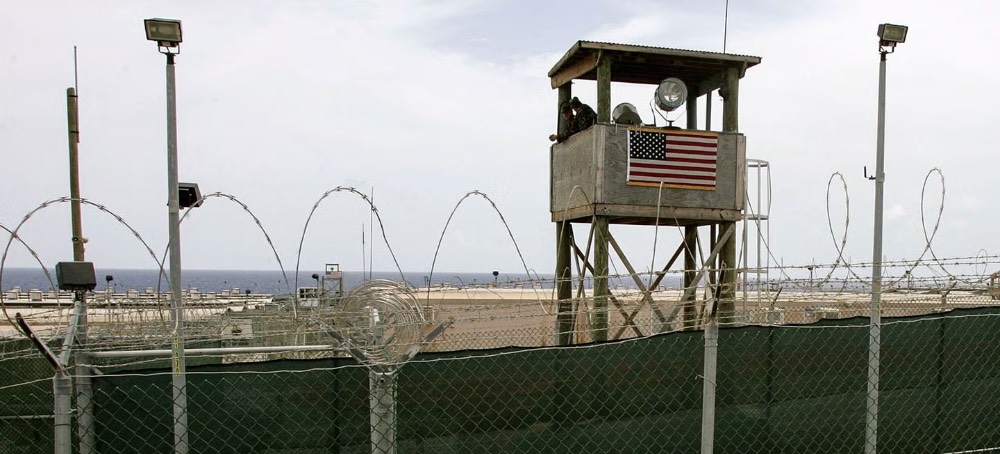Trump’s Gitmo Detention Center Would Be Bigger Than History’s Worst Concentration Camps
Pedro Gerson Slate Soldiers stand guard in a watchtower at Camp Delta at Guantanamo Naval Base in 2004 in Cuba. (photo: Mark Wilson/Getty)
Soldiers stand guard in a watchtower at Camp Delta at Guantanamo Naval Base in 2004 in Cuba. (photo: Mark Wilson/Getty) Trump’s Gitmo Detention Center Would Be Bigger Than History’s Worst Concentration Camps
Pedro Gerson SlateIn the 1980s a great number of unauthorized immigrants from Caribbean and Central American countries began arriving in the United States. Pushed out by civil war, economic destitution, and political repression, thousands of refugees from Cuba, Haiti, and El Salvador began to arrive to America. Most relevant for the present moment, the arrival of more than 100,000 Cubans and around 15,000 Haitians early in the decade overwhelmed coastal border authorities and led to widespread outrage in the country.
Back then, as today, in facing this growing influx of migrant arrivals, public officials and many in the media began referring to migration at the southern border and the coast as an invasion and calling migrants criminals. Both Haitian and Cuban migrants in particular were quickly associated with crime in the public consciousness, with the former group—similar to today’s migrants—suffering the greatest stigma.
The government responded by passing laws that criminalized migrants more heavily, by increasing the use of detention, and by fortifying and surveilling the border as it did many communities inside the country as part of its war on drugs. It’s a process that has continued to this day.
Along the way, the Clinton administration built a mass detention facility for 12,500 inmates in Guantanamo Bay. (Currently only about 4 percent of jails in the U.S. hold more than 1,000 inmates.) The detention center operated for three years and was eventually closed under great political pressure, not without first subjecting thousands of people to deplorable conditions, being housed in makeshift barracks with windows covered by taped garbage bags and fed rotten food sometimes infested with maggots.
Officially, the detention center in Guantanamo was a response to a problem of immigration enforcement, not security concerns. Like Ellis and Angel islands before it, the government’s idea was that by setting up a “processing facility” offshore it could properly analyze the legal case of each individual before affording them legal entry. This time around, there is no pretext.
Trump has consistently vilified migrants and equated them with criminals. His entire political rise is tethered to the idea that immigrants are invading the country and that only he can fix it. As Trump himself said in his statements to the press, the facility in Guantanamo is to “detain the worst criminal illegal aliens threatening the American people.”
The threat is so dire, apparently, that he plans to build a detention facility of unprecedented size in the American context. The Tule Lake Japanese internment camp, for example, had a capacity of around 18,000. If the Trump administration actually builds the detention camp in Guantanamo, it’ll double in size Auschwitz-Birkenau’s original design and be bigger than Dachau and Treblinka combined.
So no, the announcement is not simply about administering the immigration system like Clinton attempted, nor even solely about incarcerating immigrants. After all, today the government detains around 40,000 immigrants a day and could detain more in the sprawling and unused carceral infrastructure in the country. All that needs to happen is for Congress to appropriate the funds for that purpose, something it attempted to do during the Biden administration before Trump sabotaged the effort through his congressional allies.
What’s critical is this: Guantanamo today carries a particular political valence. For some it is a symbol of government abuse, but for others it is the place where terrorists are held. Trump intends to build in Guantanamo purposely to reify the same message that propelled him to power: Immigrants are criminals and they are here to hurt you. But now Trump is going further: Some of these immigrants are not only criminals, they are equivalent to terrorists. Frighteningly, this move may also be Trump signaling an intent to strip undocumented immigrants of even more rights and treat them under similarly abusive conditions as recent Guantanamo Bay detainees have experienced.
Facts, of course, have never mattered when it has come to Trump’s politics of fear. It hasn’t mattered that the majority of immigrants do not commit crimes, nor that the majority of immigrants in ICE custody did not commit crimes, nor even that this week the Trump administration arrested a majority of people who are not public safety threats. It’s been irrelevant to him that immigration detention is simply not necessary to administer the immigration system. Such detention policies are merely an expensive and punitive public employment program that does not ensure that people with valid legal claims are regularized any better than the government would without the detention policies. And today, when Trump claims he needs more beds for detainees, it’s useless to point out that undocumented entries had dropped to one of the lowest levels in recent years by the end of 2024.
Trump’s move is in line with what nativists all around the world have been doing, whether it is Australia building a (now closed) detention center in Papua New Guinea, or England sending asylum-seekers to Rwanda. Long gone are the days of solidarity with those escaping destitution and repression. The world has not only turned its back on those seeking refuge outside of their home borders, it has criminalized them. I’m afraid things are about to get worse.
